In the once-crowded field of manned combat aircraft, the F-35 Lightning II fighter now has become the only game in town.
Secretary of Defense Robert M. Gates, with his April 6 budget cut recommendations, terminated further production of the USAF F-22 fighter, began winding down the Navy’s F/A-18 carrier-based fighter, and postponed the next generation bomber, which was supposed to enter service in 2018.
That leaves only the F-35 as a full-fledged manned air program. Gates has heaped on the aircraft the burden of providing most of the capability and credibility of American airpower for decades to come.
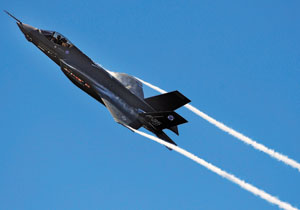 |
The first F-35 test aircraft soars over Florida on an April visit to its future home at Eglin AFB, Fla., where Air Force, Navy, and Marine Corps training will be co-located. All three services are counting on the Lightning II to address their combat aircraft deficits. |
Gates, in his budget announcement, praised the F-35 as emblematic of his vision for new weapons, saying that it would be adaptable to a wide variety of missions, producible in large numbers at “sustainable cost,” and not too specialized.
In contrast, Gates lashed out at programs he scornfully referred to as “exquisite.” By this, he evidently meant systems tailored to meet specific military requirements, lacking direct value in today’s irregular wars in Afghanistan and Iraq, or costing more (in his view) than they are worth.
He promised to field the F-35 as quickly as possible, accelerating the program by adding some aircraft to the operational test fleet. However, he didn’t change the overall target number. That would remain at 2,443 aircraft across all the services, reached in 2035.
If Gates’ plan proves out, the F-35 will be produced in numbers exceeding 100 per year for US requirements, and top 200 a year when foreign sales are included.
This production pace exceeds that posted by any fighter program since the late 1980s. F-35s will equip not only the Air Force, Navy, and Marine Corps, but also the air arms of at least eight US allies who are partnered on the program’s development, and many others that will simply buy the fighter.
Gates did not back his budget submission with a future years defense program. DOD explained that, owing to the change of Presidential Administrations, the budget had been hastily reworked.
However, Gen. Norton A. Schwartz, USAF’s Chief of Staff, later said the 513 F-35s budgeted over the next five years will yield “maybe 350” for the Air Force itself.
Schwartz noted that sustained, high-rate F-35 production will serve the US Air Force well, both in terms of “managing our aging fleet issues” but also in maintaining and controlling average unit cost of fighter platforms. That way, he said, “we can, in fact, purchase more of them and make the platform more competitive internationally at the same time.”
Schwartz and other Air Force leaders have said they see a need for 110 or more F-35s a year to recapitalize the aging USAF fighter inventory at a reasonable rate. Asked if that will be possible, Schwartz pointed out that programs “ebb and flow” and that, as some wind down, “others ramp [up], and that would certainly be my expectation for the F-35.”
USAF officials said Schwartz expects the pace of F-35 production to pick up after 2011. Gates’ plans call for closing out the F-22 program in 2011, though Congress could still intervene and keep the fighter line going.
Lockheed Martin, the F-35’s prime contractor, has tooled up to produce as many as 240 F-35s a year in its Fort Worth, Tex., facilities. Pieces of the aircraft are built among all partner countries, but that rate would be the most that could be put through final assembly and checkout without expanding the assembly line and adding additional shifts of workers. Going higher than 240 could be done, but at what one company official termed “significant expense.”
The Air Force’s need for the F-35 is already acute, as the average age of USAF fighters has crept above 17 years for the F-16, and 24 for the F-15. Some are considerably older. Moreover, the 2010 budget request included plans to retire 254 fighters from the Air Force’s fighter inventory in the next fiscal year alone; it had been thought this reduction would phase in over five years. As a result, the Air Force will drop quickly and deeply below the level of 2,250 fighters considered the minimum requirement to fulfill national strategy.
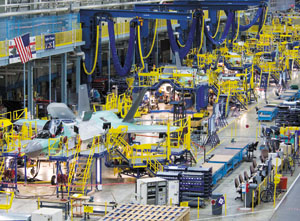 |
F-35s under assembly at Lockheed Martin’s Fort Worth, Tex., plant. At planned peak, production will surpass 200 a year for US and allied air arms. |
An Urgent Requirement
Schwartz said studies to determine how the F-35s will be distributed among the regional commands, Air National Guard, and Air Force Reserve will “come to fruition … in the next year or so.” The heads of Pacific Air Forces, US Air Forces in Europe, and the Air National Guard have all gone on record saying their commands have the most urgent requirement for the fighter.
Schwartz and Air Force Secretary Michael B. Donley, testifying before Congress in May, defended the plan to remove the older fighters from the inventory now, saying that the savings can be applied to upgrade those fighters that remain, to buy F-35s, and to improve the F-22 with more than $1 billion of enhancements in Fiscal 2010 alone, and $7 billion through 2015. The aim, they said, is to have a smaller but more capable fighter fleet, which will permit savings in manpower that can be applied to other pressing needs.
Marine Corps Gen. James E. Cartwright, vice chairman of the Joint Chiefs of Staff, said at a Pentagon press conference in April that the focus on the F-35 should be perceived as good news for the defense industry, “because the reality is, we’re going to need quantity [and] that should be actually an advantage for the industrial base.” It should be a welcome change of pace, he said, for contractors to see programs “funded at effective, efficient quantities. … We build them, we build them efficiently, and we get them out there.”
Gates, seated next to Cartwright, added that “if we can get this acquisition process in a better place, I think it will be a significant advantage for the industrial base for defense, in no small part because it will afford greater stability and predictability.”
The budget put forth by Gates would increase from $6.8 billion for 14 F-35s in Fiscal 2009 to $10.4 billion for 30 fighters in Fiscal 2010. Out-year numbers were not provided.
The Government Accountability Office, in a March report, warned against putting too much emphasis on the F-35, noting that as many as 360 aircraft will be bought before operational testing is concluded. The GAO said that a flaw discovered in testing could be expensive to fix on the production line, and that it would be pricey to retrofit the already constructed aircraft with corrections.
A new production ramp rate accounting for Gates’ acceleration has not yet been developed. Under previous plans, however, F-35 production would peak at 231 aircraft per year in 2015, of which 130 would be for the US armed services.
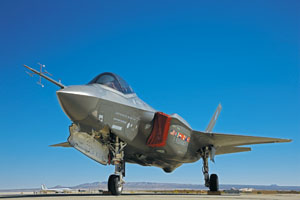 |
Sporting the flags of the nine allies partnered in its development, F-35 AA-1 awaits another test flight. As more aircraft are delivered, testing will accelerate. |
The Air Force will buy 1,763 conventional takeoff and landing F-35As. The Marine Corps will buy the short takeoff and vertical landing (STOVL) F-35B, and the Navy the carrier-compatible F-35C—together, they will buy 680 airplanes, although the exact shares of each have not yet been decided.
David G. Ahern, the Pentagon’s director of portfolio systems acquisition, told the House Armed Services’ air-land subcommittee in late May that the Pentagon is aware that putting most of the air combat eggs in the F-35 basket entails some risk. The increase in the number of aircraft available for flight testing and an extension of the flight-test program “lessened the overlap between development and operational testing, which is a good thing.”
He also acknowledged cost increases and schedule delays on the F-35, saying costs have risen “50 percent … from the original baseline.”
The increases and schedule overruns can be chalked up to “problems with manufacturing development [for] aircraft and engines. Design changes, parts shortages, out-of-station work, and supplier problems have caused significant manufacturing inefficiencies and increased labor hours that have led to higher costs and have caused the program to adjust manufacturing and delivery schedules four times, so far, in development.”
Ahern acknowledged that the F-35 plan is “still very aggressive … [with] very little room for error.” The flight-test program, he said, is only two percent complete.
Lt. Gen. Mark D. Shackelford, the Air Force’s military deputy to the chief civilian acquisition official, agreed in the same hearing that concurrency is an issue in the F-35, but pointed out that this was a choice made at the outset of the program. There was a desire to “bring that weapon system on quickly” and “reach a more economic order quantity” than was achieved on other programs, yet still thoroughly test the aircraft. These are “competing pressures,” he said.
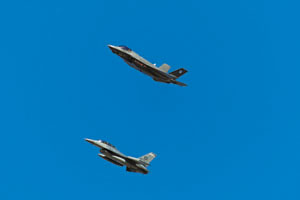 |
The first F-35 is chased by an F-16. Marine Corps Brig. Gen. David Heinz, the program executive officer, says the test effort will seek to verify predicted performance. |
Under Control
However, Shackelford added that “to mitigate that type of concurrency … a great deal of upfront investment was made in design tools … such that we have … a greater level of confidence in the design of the aircraft than we would have for legacy systems [going] back to the F-16 or F-15 days.” Over the last six months, Shackelford said, “the maturity of the physical aircraft gives us reason to believe that we’re going to get beyond the production issues” cited by the GAO and others.
Shackelford also said that the alternative engine for the F-35 can be accommodated in the program if Congress provides additional funds for its development, but that the program would be short of development funds if a second engine had to be carved out of funding for the airframe.
Managers at Lockheed Martin believe most of the turmoil in the program is in the past. Cost growth, they said, has leveled off. They believe the most significant problems have been found and addressed, and noted that one of the main cost drivers on the program—the cost of materials such as titanium—are now under their control. The company reports that the test program is going well and two of the major hobgoblins of aircraft development—weight growth and software—are well in hand.
Daniel J. Crowley, Lockheed Martin’s vice president and F-35 program manager, said weight is “not something I think about or talk about much because we’re on track to our weight projections.”
Several years ago, he said, weight was a critical issue, as it was cutting deeply into the payload that the F-35B could take off with vertically. The program was allowed a year’s delay as weight-cutting ideas of all kinds were explored and implemented. As a result of the redesigns that ensued, “we’ve been tracking now for several years to a three percent weight growth projection,” which is half of what Naval Air Systems Command anticipated. The weight savings applied to the F-35B provided some bonus payload for the Air Force and Navy versions, although the F-35B weapons bay had to be modified and as a result can only accommodate weapons up to the size of a 1,000-pound Joint Direct Attack Munition. The Air Force and Navy variants can still carry the 2,000-pound JDAM.
“We learned a lot of lessons from legacy programs” and from the F-22, Crowley said, about “structural problems that grew weight,” and these have been avoided. Also, the computer-aided design of the F-35 has allowed for far more precision in building parts—twice the computing capability available during the F-22’s design.
As a result, weight is well understood and thoroughly under control, Crowley said. In fact, he has the luxury of about 250 pounds of weight savings that are ready to go if necessary. For now, though, the additional weight reduction isn’t needed, and implementing the cuts would add cost, so they’re being held in reserve.
The weight purge of a few years ago was so “intensive,” Crowley said, that “there’s not thousands of pounds” of weight left to be saved on the F-35. However, even with a three percent annual weight growth, the key performance parameters, or KPPs, won’t be affected.
“All of our predictions for performance are based on an end-of-life, worst-case” scenario relative to the F135 engine’s power capacity, “so the true performance of the jet, throughout its life, will be much better.”
Crowley also reported that software—problems which hamstrung the F-22 in the last few years of its development—is not an issue on the F-35.
“We’re well along in software,” Crowley said. “We’re meeting our productivity numbers today, and we’re doing the early sensor fusion.”
In flight testing so far, “we haven’t had any software-related flight anomalies. They’ve all been hardware. And we haven’t had any ground aborts that were related to software.” Unlike the F-22, which used “shared processors across multiple subsystems, … we have different processors for each of the sensors and then they’ve isolated the software so that you don’t get” the in-flight software crashes experienced during F-22 flight tests.
Because the software is done in a number of locations, Lockheed Martin hasn’t scarfed up all the writers of code in central Texas or Los Angeles.
“We have spread the work around pretty well, so we haven’t found [availability of programmers] to be a bottleneck.”
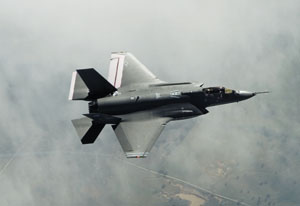 |
The F-35 now is the only new combat aircraft on the books. Initial operational capability is slated for 2012 in Marine Corps squadrons, 2013 for the Air Force. |
Moreover, to reduce the overlap between development and production, Lockheed Martin is using a flying laboratory—a 737 configured with an F-35 nose and wing leading edges—to try out the sensors and create the sensor fusion that will be a hallmark of the F-35. Sensor integration testing on the flying surrogate is well along, and by the time operational F-35s are moving down the production line, any bugs should be worked out, Crowley said.
With weight and software under control, Crowley said his biggest worry is “maintaining a steady supply of parts with quality, on time.” Process management at the Fort Worth plant is not an issue, he said, and the production line will be moving 58 inches a day by the end of the year.
Crowley said much of the credit for the F-35 not veering off schedule and staying within its weight limits is the fact that the various stakeholders in the program have a vested interest in avoiding “requirements creep,” which has plagued most other systems in the last decade.
Pay Per Difference
“Every partner or service has to pay to be different,” Crowley said, and that has tamped down the urge to ask for unique gear or capabilities. Moreover, he said, service acquisition executives and the Joint Executive Steering Board have adopted an attitude that “if we’re going to add things to the jet, we’re going to take things off,” so they don’t add to the degree of difficulty. An automatic ground collision avoidance system, for example, was moved from early in the program to a later block upgrade, mainly because a separate government software program was behind schedule.
The F-35s will be updated in two-year increments.
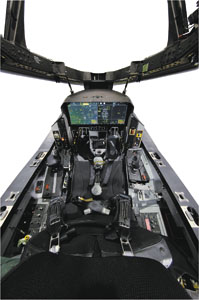 |
Cockpit displays will complement data projected on the pilot’s helmet. Variants will have nearly identical layouts. |
“Our parts fit up and mate with [far less] shimming than we’ve ever seen in legacy jets,” Crowley noted. “And we’re running defect rates that are comparable [to] or lower than mature programs today because we designed parts to such close tolerances,” with computer-aided design, “that are much more conforming.”
Former Air Force acquisition executive Sue C. Payton, in an exit memo on the status of the F-35 program early this year, deemed its health “mixed,” due to cost increases, concurrency, early cost jumps on the F135 engine, and the slowly building pace of flight testing. She expressed concerns about overhead costs on the program, which have ratcheted up in recent years.
However, Payton’s overall assessment was that “I am confident in the program’s risk management plan, and expect that with proper government oversight, the program can achieve the required technical performance.” She urged that as soon as possible, the F-35 become a fixed-price contract rather than the existing cost-plus.
Crowley said that he expects that will happen, and the program will be ready when it does.
| Internal Vs. External
The F-35 was designed with an entire air campaign in mind. For “first day of the war” operations when stealth is of supreme importance, the F-35 can carry two 2,000-pound bombs (two 1,000-pound bombs for the F-35B) and two radar guided dogfight missiles internally. Critics of the F-35 have complained that this loadout is far too light for sustained combat. However, in stealth configuration, all F-35 fuel is internal, as are all sensor and targeting systems. On legacy aircraft such as the F-16, fuel, weapons, targeting pods, etc., are carried externally and their weight and drag severely hamper performance. With a full internal load of fuel and weapons, the F-35 is as agile as a “clean” F-16 carrying no weapons. In other words, in stealth mode, the F-35 gives up nothing in range or weaponry, but adds considerable ability to penetrate enemy air defenses. After enemy defenses have been beaten down, however—Week 2 of an air campaign—the F-35 becomes a weapon-hauling champ, with seven external hardpoints able to carry up to about 18,000 pounds of ordnance (15,000 on the STOVL model), including weapons too large to fit in its internal weapon bays. The F-35 can also be fitted with wingtip missile launch rails, to expand its ability to conduct air superiority missions. |
| “The Last Manned Aircraft”
In testimony before the Senate Armed Services Committee in May, Chairman of the Joint Chiefs of Staff Adm. Michael G. Mullen said, “There are those that see the [F-35] as the last manned fighter—or fighter-bomber—or jet, and I’m one that’s inclined to believe that.” Mullen said the pace of evolution in unmanned aircraft has accelerated so rapidly just since 2006 that the Pentagon is re-evaluating many of its plans for manned combat aircraft, such as the next generation bomber. Mullen, a naval aviatior himself, said, “We’re at a real time of transition here, in terms of the future of aviation, and the whole issue of what’s going to be manned and … unmanned, what’s going to be stealthy, what isn’t, [and] how do we address these threats.” Mullen’s remarks were seen as a sign that the F-35 program, which will likely be negotiated in multiyear contracts, may never reach the planned production of 2,443 for the US, but could at some point be superceded by an unmanned aircraft with comparable capabilities. |
| “Maneuverability Is Irrelevant”
For all of the Pentagon’s recent claims, the F-35 was always intended to be a complement to the F-22 in the Air Force. The F-22 would be the high-speed, very stealthy high-end guarantor of air supremacy, while the F-35 was cast as the lower-cost backbone fighter that could hold its own in a dogfight and swing to a variety of missions, but have special strengths in ground attack. The F-35’s air-to-air capabilities were developed to give it an edge against the most maneuverable of foreign fighters, since it will be the primary aircraft for most allied air forces. The Air Force version of the F-35 will have the ability to sustain a nine G turn—equal to that of the F-15 and the F-16. The Navy and Marine Corps models will have 7.5G turning power, and a Lockheed Martin official said those versions will shine in the “low speed” dogfight. However, according to Northrop Grumman, which supplies major sensor systems on the F-35, “maneuverability is irrelevant” for the F-35. The AN/AAQ-37 Distributed Aperture System, which projects a 360-degree image of surrounding air and terrain on the F-35 pilot’s helmet visor, helps the pilot see and target air and ground threats with high fidelity. It eliminates the need for night vision goggles, which have limited field of view and must be compatible with cockpit lighting. With the DAS, the F-35 pilot can literally look “through” the airframe structure—even beneath the aircraft—and shoot at targets that aren’t in front of him. Air-to-air missiles can actually be fired at targets to the rear. According to Northrop Grumman, instead of having to slug it out in a turning battle, “the F-35 simply exits the fight, and lets its missiles do the turning.” |
| Fielding the F-35
The first F-35A flew in late 2006, but the design has changed slightly since that first aircraft, and it was not fully representative of a production model. The first F-35B flew in June 2008 (although by late May 2009 it had not yet flown in vertical mode), and both the updated F-35A and F-35C are to make their maiden flights in 2009. Sixty operational aircraft will be delivered to Eglin AFB, Fla., between 2010 and 2013, for use by USAF, USMC, and Navy training squadrons. The Marine Corps will achieve initial operational capability with the F-35 in 2012, the Air Force in 2013, and the Navy in 2015. Beddown locations for the Air Force F-35As have not yet been established; USAF Chief of Staff Gen. Norton A. Schwartz said in May it will take “about a year” to decide how the aircraft will be divided among the combat commands, and in what order they will receive them. |
| The Allied Buys
The eight other countries partnered in the development of the F-35 plan to acquire 730 of the aircraft, and these plans have survived numerous reviews and re-evaluations among all the partner parliaments and defense ministries. Current orders are as follows: Britain: 138 Italy: 131 Australia: 100 Turkey: 100 Netherlands: 85 Canada: 80 Denmark: 48 Norway: 48 In addition, Israel is planning an initial order of at least 25 aircraft. Other countries which have either formally expressed interest or requested formal F-35 briefings include Singapore, Japan, South Korea, Greece, Spain, Finland, and Belgium. All countries that bought F-16s, F/A-18s, or AV-8Bs—the main aircraft that the F-35 replaces—are considered potential customers, and there are more than 40 such nations. |